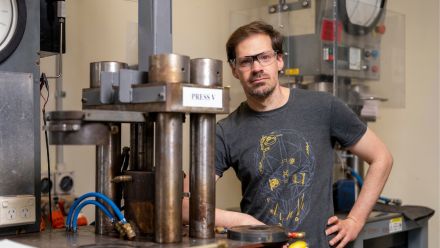Nanoparticles control light like road signs direct traffic
The particles control the flow of light like road signs control traffic on a busy road by manipulating the direction in which light can, or can’t, travel.
Physicists at The Australian National University (ANU) have tiny translucent slidescapable of producing two very different images depending on the direction in which light travels through them.
As light passes through the slide, an image of Australia can be seen, but when you flip the slide and look again, an image of the Sydney Opera House is visible. The pair of images created is just one example of an untapped number of possibilities.
The ability to produce two distinctly different images is possible thanks to the ºÚÁÏ̀́̀Ăscientists' ability to control the direction in which light can and can't travel at the nanoscale. The development could pave the way for new light-based devices that could lead to faster, cheaper and more reliable Internet. It could also serve as the foundation for many of the technologies of tomorrow.
Developed in collaboration with colleagues from China, Germany and Singapore, thenew technologyuses nanoparticles, so small that about 12,000 of them can fit within a cross-section of a human hair. These tiny particles are arranged into unique patterns on the slides.
"Theparticles control the flow of light like road signs control traffic on a busy road by manipulating the direction in which light can, or can't, travel," project leader Dr Sergey Kruk said.
"Some particles allow light to flow from left to right only, others from right to left or the pathway might be blocked in either direction."
Dr Lei Wang, from Southeast University in China said: "While the purpose of these images is mainly artistic, they demonstrate the potential for this new technology.
"In real-world applications thesenanoparticles can be assembled into complex systems that would control the flow of light in a useful manner - such as in next-generation communications infrastructure."
According to Dr Kruk, the ability to control the flow of lightat the nanoscale ensures light "goes where it's supposed to go and doesn't go where it'snot supposed to".
"We exchange enormous amounts of information with the help of light. When you make a video call, say, from Australia to Europe, your voice and image get converted into short pulses of light that travel thousands of kilometres through an optical fibre over the continents and oceans," Dr Kruk, from the ºÚÁÏ̀́̀ĂNonlinear Physics Centre, said.
"Unfortunately, when we use current light-based technologies to exchange information a lot of parasitic effects might occur. Light might get scattered or reflected, which compromises your communication.
"By ensuringlight flows exactly where it needs to flow, we would resolve many issues with current technologies."
While there are already devices available on the market, known as optical isolators, that can control the flow of light, this technology isn'twithout its drawbacks.
"Optical isolators are indispensable in many high-end light-based technologies such as powerful lasers and ultra-fast optical communication networks, but they are quite large in size and are also expensive, which prohibits a wider deployment of these components," Dr Kruk said.
"By contrast, our devices are created using nanofabrication technology. This allows us to drastically reduce the size of a component to less than one thousandth of a millimetre and reduce production costs to just a fraction of an Australian dollar.
"Currently there is one important difference between an optical isolator and the first generation of our translucent slides. Our slides change the colour of light, or in other words, the frequency at which the wave of light oscillates, while an optical isolator does not.
"We are now working on the second generation of this technology that will control the flow of light in the same way, while maintaining its colour."
According to Dr Kruk, the development of many technologies of tomorrow will rely heavily on our ability to control light at a tiny scale.
"A wide deployment of tiny components that can control the flow of light could potentially bring technological and social changes similar to transformations brought about in the past by the development of tiny components that control the flow of electricity, which are known as diodes and transistors," he said.
"Control over the flow of electricity at the nanoscale is what ultimately brought us modern computers and smartphones. It is therefore exciting to envision the potential of our emerging technology for controlling flow of light."
This research was a collaboration between the Nonlinear Physics Centre at the ºÚÁÏ̀́̀ĂResearch School of Physics,Paderborn University in Germany, Southeast University in China and A*STAR Singapore. The researchis published in .


